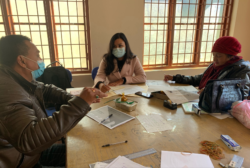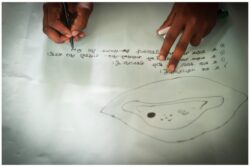Project details: Tackling AMR in Schools
Aims
Aim: Create bespoke resources which introduce 12-15 year old children to the issue of AMR.
- Work with previous research participants to understand the key messages on AMR they would like to share in schools.
- Work with the local community including school staff, to co-create educational resources on AMR.
- Engage local school students to review drafts of resources.
- Pre-test resources in 2 Nepali high schools.
 Due to the COVID-19 pandemic this project worked predominantly online but did manage some face-to-face sessions with teachers. HERDi researchers are seen here in a COVID-safe focus group, discussion changes to the resources with two high school teachers.
Due to the COVID-19 pandemic this project worked predominantly online but did manage some face-to-face sessions with teachers. HERDi researchers are seen here in a COVID-safe focus group, discussion changes to the resources with two high school teachers.
Additional aims
In July 2022 the team was awarded a small Impact Acceleration Award from the University of Leeds to test the impact of the materials in new schools who were not involved in the co-development process. The scope of this sub-project was to:
- Test the ability of co-produced AMR educational materials to impact on AMR knowledge, attitudes and practices of teachers and students.
- Engage with policy level stakeholders to discuss the potential for co-produced AMR resources to be incorporated into the Nepal curriculum for high school students.
 These testing sessions were extremely engaging and interactive with students really enjoying the creative activities! The feedback is currently being evaluated by our team and we are looking forward to sharing results soon!
These testing sessions were extremely engaging and interactive with students really enjoying the creative activities! The feedback is currently being evaluated by our team and we are looking forward to sharing results soon!
Methods
This project used focus group discussions, feedback sessions, participatory and co-design approaches across a series of online workshops to create educational resources to be used in schools.
We began conducting a series of online workshops with participants involved in our previous participatory video project (CARAN). We wanted to know what AMR information they felt was most important to share with school students.
We collated this feedback into a PowerPoint presentation which was delivered to teaching and school support staff in two schools. These staff then engaged in online/phone discussions to share their feedback on the suitability of the material for schools.
From these conversations it became apparent that we need to work on two issues, firstly what material to share and how much detail to go into on AMR as a topic. Secondly, what format to share the material in.
Re-shaping ideas
In later online focus groups both teachers and students really liked the idea of leaning in more creative ways such as through drama, arts and crafts. However both sets of stakeholders suggested that this may not be possible within school settings.
Students and teachers both wanted to know more about the biology of AMR - how microbes become resistant for example. We were surprised by this finding and so adapted our resources to include a lot more detail.
Creativity
Both groups wanted resources to be fun and bright! We worked with a graphic designer to create our final materials.
Iteration
The process behind this project was lengthily and iterative, involving several stages of community feedback to co-develop the final resources. Drafts were frequently circulated back to community stakeholders including school staff and students for feedback which was actioned by the research team.
